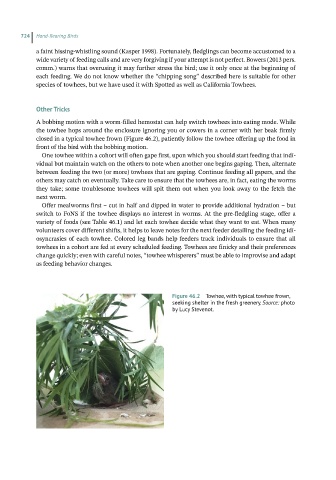Page 722 - Hand rearing birds second
P. 722
724 Hand-Rearing Birds
a faint hissing‐whistling sound (Kasper 1998). Fortunately, fledglings can become accustomed to a
wide variety of feeding calls and are very forgiving if your attempt is not perfect. Bowers (2013 pers.
comm.) warns that overusing it may further stress the bird; use it only once at the beginning of
each feeding. We do not know whether the “chipping song” described here is suitable for other
species of towhees, but we have used it with Spotted as well as California Towhees.
Other Tricks
A bobbing motion with a worm‐filled hemostat can help switch towhees into eating mode. While
the towhee hops around the enclosure ignoring you or cowers in a corner with her beak firmly
closed in a typical towhee frown (Figure 46.2), patiently follow the towhee offering up the food in
front of the bird with the bobbing motion.
One towhee within a cohort will often gape first, upon which you should start feeding that indi-
vidual but maintain watch on the others to note when another one begins gaping. Then, alternate
between feeding the two (or more) towhees that are gaping. Continue feeding all gapers, and the
others may catch on eventually. Take care to ensure that the towhees are, in fact, eating the worms
they take; some troublesome towhees will spit them out when you look away to the fetch the
next worm.
Offer mealworms first – cut in half and dipped in water to provide additional hydration – but
switch to FoNS if the towhee displays no interest in worms. At the pre‐fledgling stage, offer a
variety of foods (see Table 46.1) and let each towhee decide what they want to eat. When many
volunteers cover different shifts, it helps to leave notes for the next feeder detailing the feeding idi-
osyncrasies of each towhee. Colored leg bands help feeders track individuals to ensure that all
towhees in a cohort are fed at every scheduled feeding. Towhees are finicky and their preferences
change quickly; even with careful notes, “towhee whisperers” must be able to improvise and adapt
as feeding behavior changes.
Figure 46.2 Towhee, with typical towhee frown,
seeking shelter in the fresh greenery. Source: photo
by Lucy Stevenot.

